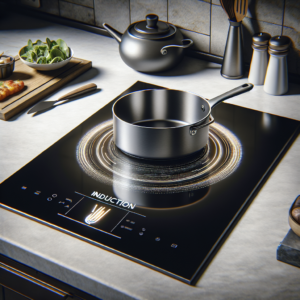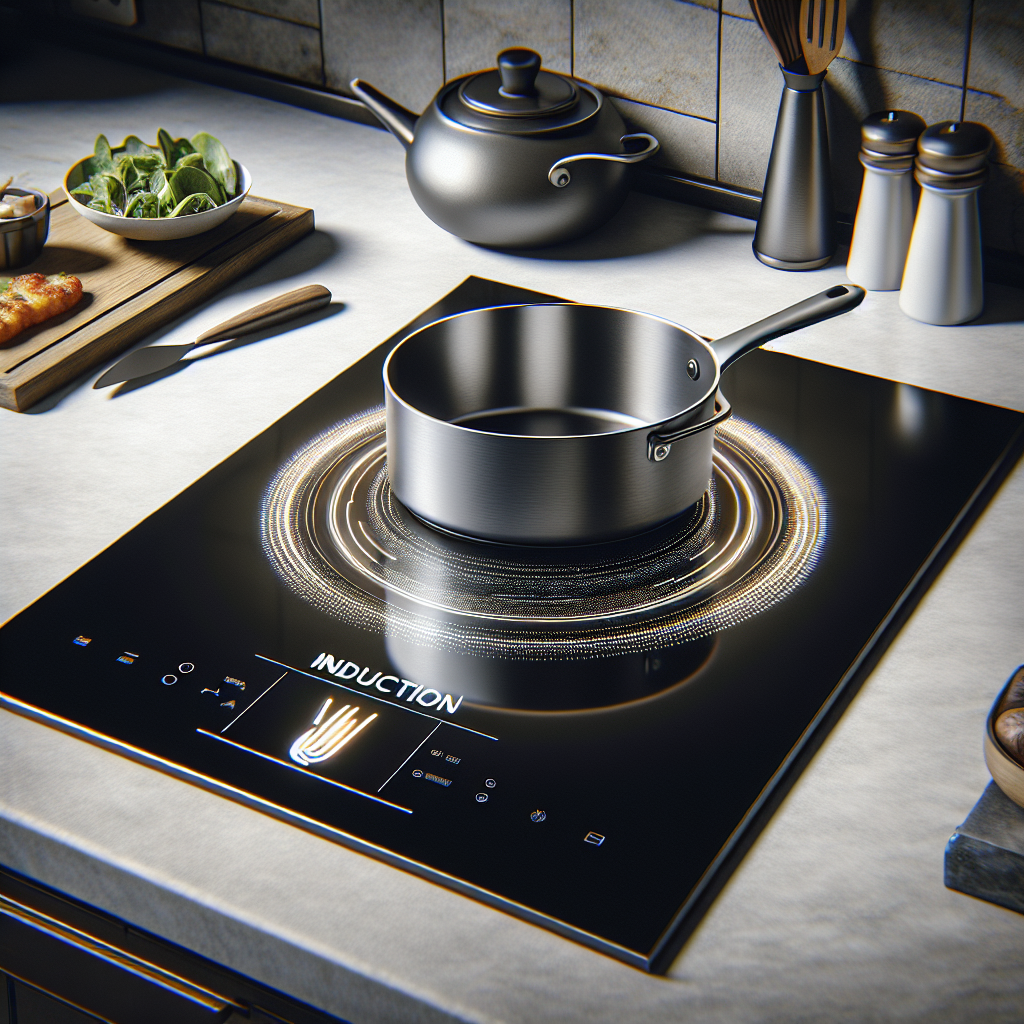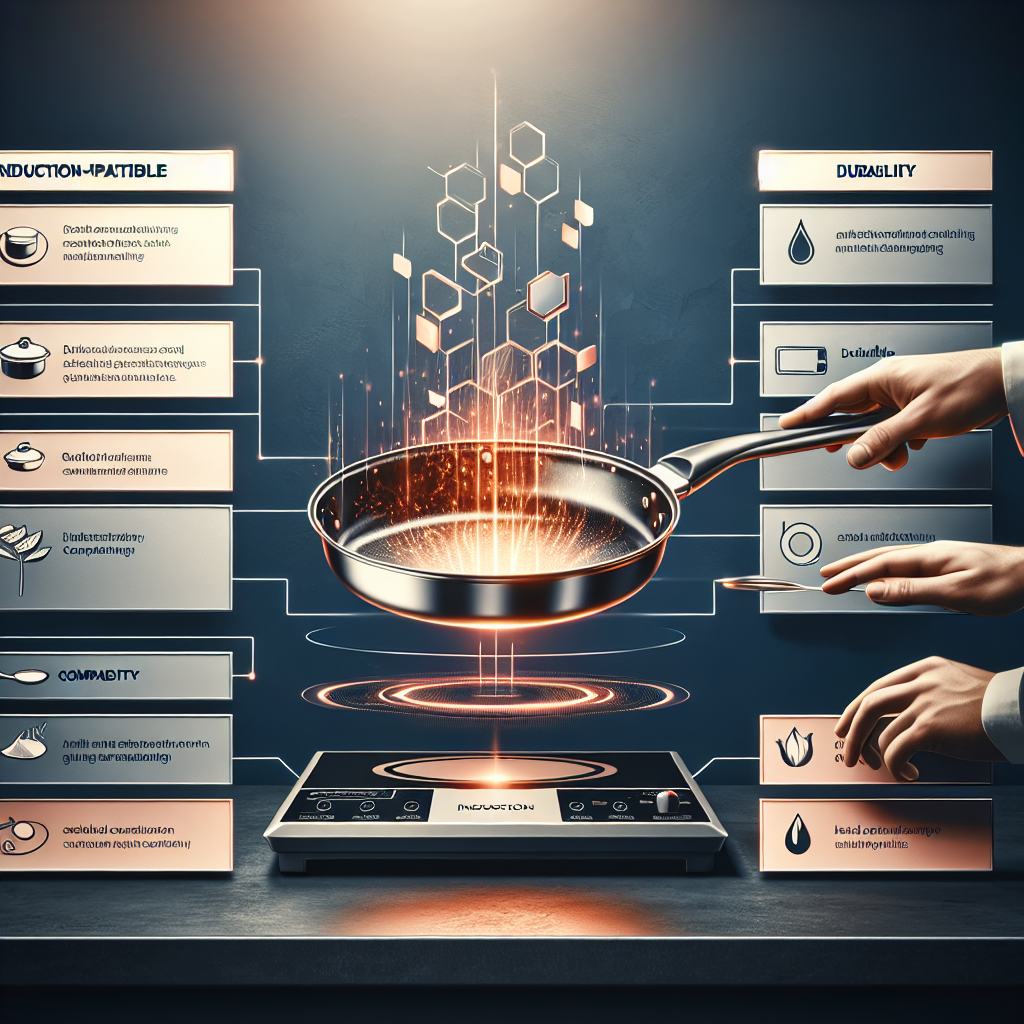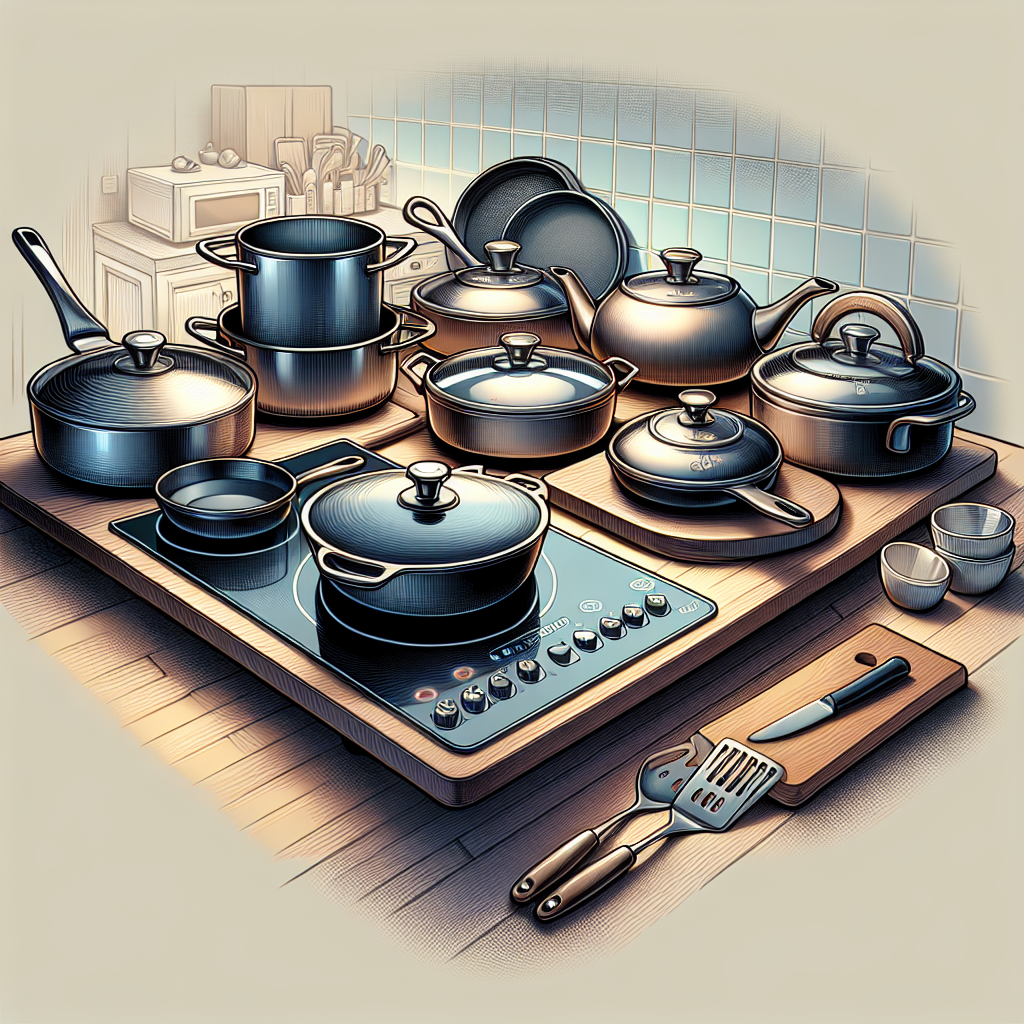How Do I Choose The Right Type Of Cookware For An Induction Cooktop?
November 20, 2023

If you’re eager to make the most of your induction cooktop but find yourself unsure about which cookware works best, worry not! Choosing the right type of cookware for an induction cooktop can seem like a daunting task, but with a few helpful tips, you’ll be well on your way to creating delicious meals effortlessly. From understanding the importance of magnetic materials to exploring the various features to consider, this article will guide you towards selecting the perfect cookware for your induction cooktop. Choosing the right type of cookware for an induction cooktop is essential to ensure efficient and effective cooking. Induction cooktops require specific types of cookware that are compatible with their magnetic technology. In this article, we will explore the various types of cookware that are suitable for induction cooktops, considerations to keep in mind when choosing cookware, factors that affect cookware performance on induction cooktops, and common questions about cookware for induction cooktops.

Types of Cookware Compatible with Induction Cooktops
Stainless Steel Cookware
Stainless steel cookware is one of the most popular choices for induction cooking. It is durable, non-reactive, and provides even heat distribution. When selecting stainless steel cookware for an induction cooktop, make sure that the base is magnetic, as some stainless steel alloys are not compatible with induction.
Cast Iron Cookware
Cast iron cookware is another excellent choice for induction cooktops. It is known for its superior heat retention and even cooking. However, not all cast iron cookware is induction compatible. Look for cookware labeled as “induction-ready” or with a magnetic base to ensure compatibility.
Enameled Cast Iron Cookware
Enameled cast iron cookware is a variation of traditional cast iron cookware that features a porcelain enamel coating. This type of cookware is not only compatible with induction cooktops but also offers the added benefit of easy cleaning and a wide range of stylish colors.
Carbon Steel Cookware
Carbon steel cookware, similar to cast iron, is a great choice for induction cooking. It heats up quickly and evenly, making it ideal for high-heat cooking methods, such as stir-frying. Ensure that the carbon steel cookware has a magnetic base for compatibility with induction cooktops.
Copper Cookware
Copper cookware is not inherently induction compatible, as copper is not magnetic. However, some manufacturers offer copper cookware with an added magnetic disk on the bottom to make it suitable for induction cooktops. It is essential to check the compatibility of copper cookware before using it on an induction cooktop.
Aluminum Cookware
Aluminum cookware is not directly compatible with induction cooktops, as it is not magnetic. However, some brands produce aluminum cookware with a magnetic base or a layer of magnetic material, allowing it to work on induction cooktops. Look for aluminum cookware labeled as “induction-ready” for compatibility.
Clad Cookware
Clad cookware consists of multiple layers of different materials, typically stainless steel with an aluminum or copper core. This combination provides the benefits of each material, such as even heat distribution from the aluminum or copper core and durability from the stainless steel exterior. Clad cookware is a popular choice for induction cooktops.
Non-Magnetic Cookware
Non-magnetic cookware, such as glass, ceramic, or pure copper, is not compatible with induction cooktops. These materials do not have the necessary magnetic properties to generate heat. It is crucial to check the magnetic properties of cookware before using it on an induction cooktop.
Induction-Compatible Cookware Sets
Many cookware manufacturers offer induction-compatible cookware sets, which can be a convenient option for those starting fresh or looking to replace their old cookware. These sets typically include a variety of pots, pans, and lids specifically designed for induction cooking. Look for reputable brands that provide a warranty for their induction-compatible cookware sets.
Cookware Compatibility Check Tools
To determine if your existing cookware is compatible with an induction cooktop, you can use cookware compatibility check tools. These tools consist of a magnet that can be placed on the bottom of the cookware. If the magnet sticks to the base, it indicates that the cookware is magnetic and compatible with induction. If the magnet does not stick, it means that the cookware is not suitable for induction cooking.
Considerations for Choosing Cookware for an Induction Cooktop
Budget
Before purchasing cookware for an induction cooktop, it is essential to consider your budget. Cookware prices can vary significantly depending on the brand, material, and quality. Set a budget that aligns with your needs and preferences.
Cooking Style and Frequency
Consider your cooking style and frequency when choosing cookware for an induction cooktop. If you are an avid cook who frequently prepares elaborate meals, investing in high-quality, durable cookware may be more advantageous. On the other hand, if you only cook occasionally or have a limited budget, opting for more affordable options may be suitable.
Durability and Longevity
Durability and longevity are crucial factors to consider when selecting cookware for an induction cooktop. Look for cookware made from high-quality materials that are resistant to warping, scratching, and staining. Read customer reviews and look for warranties to ensure that the cookware is built to last.
Maintenance and Care
Consider the maintenance and care requirements of the cookware you choose. Some types of cookware may require special cleaning methods or seasoning, while others may be dishwasher safe. Assess your willingness to maintain and care for the cookware accordingly.
Heat Distribution and Retention
Induction cooktops heat cookware through electromagnetic fields, requiring efficient heat distribution and retention. Look for cookware with materials that distribute and retain heat evenly, such as stainless steel, cast iron, or clad cookware. This will help prevent hot spots and ensure consistent cooking results.
Weight and Handle Design
The weight and handle design of cookware can impact your cooking experience. Consider the weight of the cookware, especially if you have mobility issues or prefer lightweight options. Additionally, choose cookware with comfortable, heat-resistant handles for safe and easy handling.
Cookware Size and Shape
The size and shape of cookware should align with your cooking needs. Consider the number of people you typically cook for and the types of dishes you prepare. Ensure that the cookware can accommodate the amount of food you cook without overcrowding or leaving excessive empty space.
Induction Cooktop Settings
Induction cooktops often come with various settings and power levels. Check if the cookware you choose is suitable for the specific power levels of your induction cooktop. Some cookware may perform better at higher power levels, while others may be more suitable for lower heat settings.
Safety Features
Look for cookware with safety features such as heat-resistant handles, tight-fitting lids, and non-slip bases to prevent accidents and ensure safe cooking. Consider features like stay-cool handles and lids with steam vents to enhance safety and convenience.
Induction Cookware Warranty
When purchasing cookware for an induction cooktop, it is advisable to check if the manufacturer offers a warranty. A warranty can provide peace of mind and protection against any manufacturing defects or issues. Be sure to read the terms and conditions of the warranty before making a purchase.

Factors Affecting Cookware Performance on Induction Cooktops
Magnetic Properties
Induction cooktops generate heat through electromagnetism, requiring cookware with magnetic properties. Magnetic materials, such as iron, steel, and some stainless steel alloys, are compatible with induction cooktops. Cookware made from non-magnetic materials, such as aluminum or copper, needs additional magnetic layers or disks to work on induction.
Flat and Smooth Bottom Surface
To ensure optimal contact with the induction cooktop, the bottom surface of the cookware should be flat and smooth. Uneven or warped bottoms can lead to inefficient heat transfer and may result in uneven cooking.
Thick and Even Base
Cookware with a thick and even base promotes better heat distribution and retention. Thicker bases can help prevent hot spots and maintain a steady temperature, enhancing the overall cooking experience.
Proper Size and Shape
The size and shape of the cookware should match the size and shape of the induction cooking zone. Using cookware that is too small or too large for the cooking zone can lead to inefficient heat transfer and may result in longer cooking times.
Lid Design
A well-fitting lid is essential for efficient cooking on an induction cooktop. It helps trap heat and steam, allowing food to cook more quickly and evenly. Look for cookware with lids that have a tight seal and steam vents for better control of the cooking process.
Induction Coils Alignment
The alignment of the induction coils in the cooktop and the base of the cookware can affect cooking performance. Proper alignment ensures maximum heat transfer and efficiency. Ensure that the base of the cookware covers the induction coils fully for optimal performance.
Heat Conductivity
Different materials have varying heat conductivity properties. For induction cookware, materials with high heat conductivity, such as copper or aluminum, can provide quick and even heat distribution. However, the material must also have a magnetic base for compatibility.
Compatibility with Induction Settings
Check if the cookware is compatible with the specific power levels and temperature settings of your induction cooktop. Some cookware may perform better at higher power levels, while others may be designed for low-heat cooking. Ensuring compatibility can help achieve the desired cooking results.
Quality Manufacturing
Choosing cookware from reputable brands known for their quality manufacturing can increase the likelihood of better performance on an induction cooktop. Look for cookware that is well-made, with attention to detail and quality control.
User Reviews and Recommendations
Reading user reviews and seeking recommendations from others who have experience with induction cooktops can provide valuable insights. Consider the experiences and feedback of other users to make an informed decision when selecting cookware for your induction cooktop.
Common Questions about Cookware for Induction Cooktops
Can I Use Non-Induction Cookware on an Induction Cooktop?
Non-induction cookware, such as glass or ceramic, is not compatible with induction cooktops. The magnetic fields generated by induction cooktops require cookware with magnetic properties to generate heat. Using non-induction cookware on an induction cooktop will not heat up the cookware.
Will All Stainless Steel Cookware Work on Induction?
Not all stainless steel cookware is compatible with induction cooktops. Some stainless steel alloys are non-magnetic, making them unsuitable for induction cooking. When selecting stainless steel cookware for an induction cooktop, look for cookware with a magnetic base.
What is the Best Material for Induction Cookware?
The best material for induction cookware depends on personal preferences and cooking needs. Stainless steel, cast iron, and clad cookware are popular choices for induction cooking due to their magnetic properties and heat retention capabilities. Consider factors such as heat conductivity, durability, and maintenance requirements when choosing the best material for your induction cookware.
Can Induction Cookware Be Used on Other Stovetops?
Induction cookware can typically be used on other stovetops, such as gas or electric, as long as the cookware is compatible with the specific stovetop. However, it is important to note that cookware designed for induction may perform differently on non-induction stovetops.
Is Induction Cookware More Expensive?
Induction cookware can range in price, just like cookware for other types of stovetops. While some induction-compatible cookware may be more expensive due to the use of specific materials or manufacturing processes, there are also affordable options available. It is possible to find induction cookware that fits various budgets and preferences.
Can I Convert My Existing Cookware for Induction Cooking?
It is not possible to convert non-induction cookware into induction-compatible cookware. The magnetic properties required for induction cooking are inherent to the materials used in the cookware’s construction. If your existing cookware is not compatible with induction, it is necessary to purchase new cookware specifically designed for induction cooktops.
How Do I Test Cookware for Induction Compatibility?
To test cookware for induction compatibility, you can use a simple magnet. Place the magnet on the bottom of the cookware. If the magnet sticks firmly, it indicates that the cookware is magnetic and compatible with induction cooktops. If the magnet does not stick, it means that the cookware is not suitable for induction cooking.
Do I Need to Buy a Full Set or Individual Pots and Pans?
Whether you need to buy a full set or individual pots and pans depends on your cooking needs and preferences. A full set of cookware can provide versatility and convenience, offering various sizes and types of cookware for different cooking tasks. If you already have some cookware and only need specific pieces for induction cooking, purchasing individual pots and pans may be more cost-effective.
Do I Have to Replace All My Cookware for Induction Cooking?
If you are transitioning to an induction cooktop, you may need to replace cookware that is not compatible with induction. However, it is not necessary to replace all your cookware unless it is non-induction compatible. You can keep and use any existing cookware that is suitable for induction cooktops.
Can Induction Cookware Be Used in the Oven?
Many induction-compatible cookware pieces can be used in the oven. However, it is important to refer to the manufacturer’s guidelines to ensure that the cookware is oven-safe. Look for cookware with oven-safe temperature ratings and avoid using cookware with plastic or wood handles in the oven.

Conclusion
Choosing the right cookware for an induction cooktop is essential for efficient and enjoyable cooking. Stainless steel, cast iron, enameled cast iron, carbon steel, copper, and clad cookware are all compatible with induction cooktops. Factors such as budget, cooking style, durability, maintenance, heat distribution, weight, and handle design should be considered when selecting induction cookware. Understanding the factors that affect cookware performance on induction cooktops, such as magnetic properties, base surface, size and shape, and heat conductivity, can help improve cooking results. By considering these factors and addressing common questions, you can confidently choose the right type of cookware for your induction cooktop. Happy cooking!
